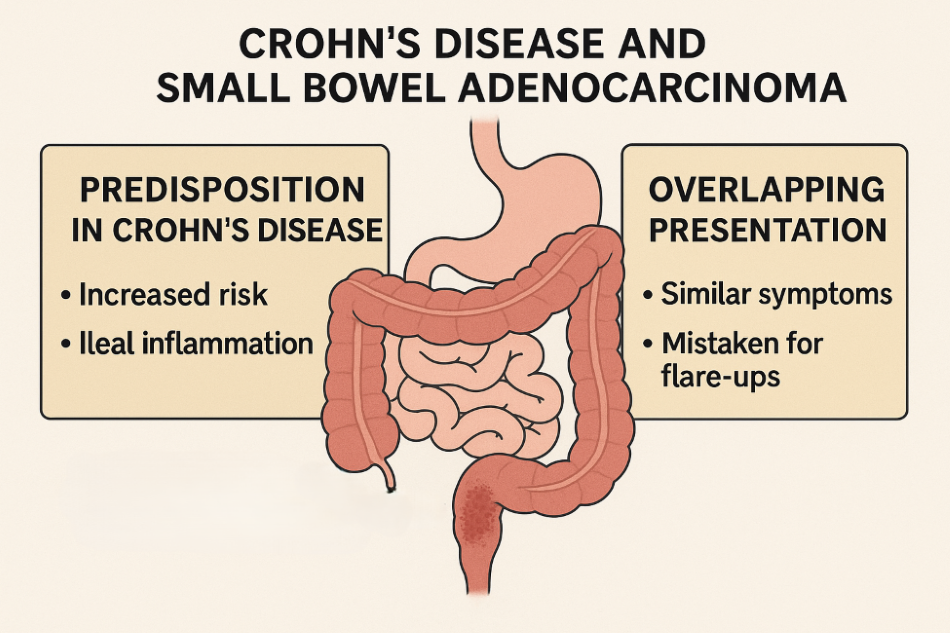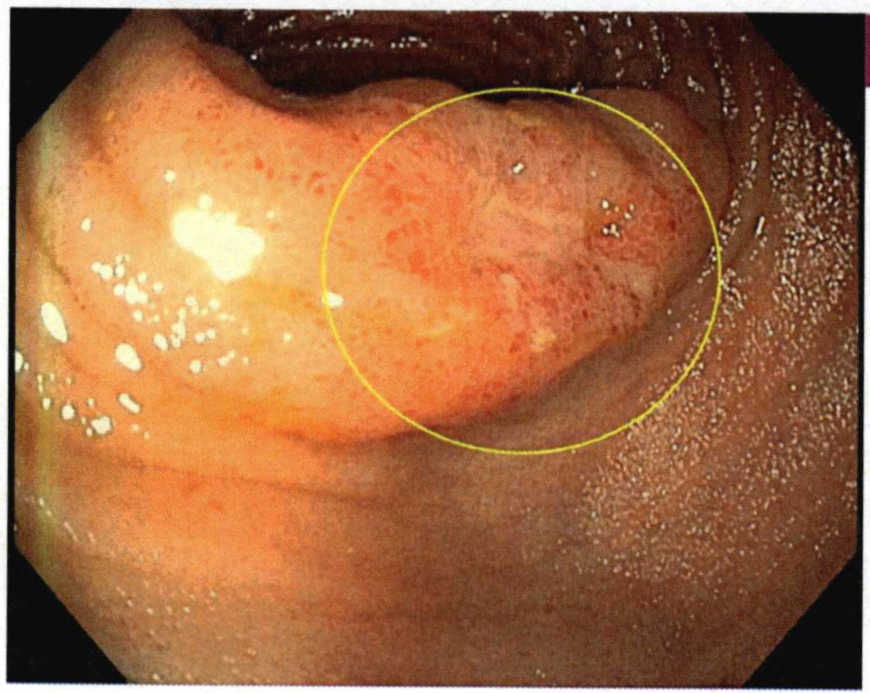Sunday Poster Session
Category: Small Intestine
P1987 - When Inflammation Turns Malignant: A Rare Case of Small Bowel Adenocarcinoma Arising in Crohn’s Disease
Sunday, October 26, 2025
3:30 PM - 7:00 PM PDT
Location: Exhibit Hall

Wagmah Javed Khan, MD
St. Luke's Hospital
Chesterfield, MO
Presenting Author(s)
Wagmah Javed. Khan, MD1, Muhammad Arsalan, MD1, Hameed Ullah, MD1, Anas M. Hasic, MD2, Sajid Zafar, MD3
1St. Luke's Hospital, Chesterfield, MO; 2Sarajevo School of Science & Technology, Saint Louis, MO; 3St. Luke's Hospital, Saint Louis, MO
Introduction: Small bowel adenocarcinoma is a rare but sinister complication of Crohn's Disease (CD). There is an increased incidence of small bowel adenocarcinoma in CD; 0.2 percent at 10 years and 2.2 percent at 25 years, but the strength of association is unclear. It commonly arises in the primary site of inflammation in CD, the ileum, vs the most common site, the duodenum. CD's transformation into malignancy is masked by overlapping symptoms and is mistaken for flare-ups. We present a case of small bowel adenocarcinoma diagnosed intraoperatively in a patient with a long-standing history of ileal Crohn's disease.
Case Description/
Methods: A 72-year-old female with Crohn’s disease involving the terminal ileum presented with left lower abdominal pain, vomiting, and diarrhea. A colonoscopy one year prior revealed a normal-appearing ileum and mild diverticulosis in the sigmoid colon, and a biopsy confirmed mild terminal ileum inflammation. Recent imaging showed left pelvic wall thickening and dilated right abdominal and pelvic bowel loops. This was managed conservatively as a diagnosis of Crohn’s disease flare-up. Despite conservative management, symptoms did not improve.
Repeat imaging revealed a high-grade small bowel obstruction in the left pelvic ileum, adjacent small abscesses, a possible sinus tract to the small bowel, and potential fistula formation with the sigmoid colon. Due to persistently worsening symptoms, an exploratory laparotomy resulted in ileocolic resection. Pathology revealed poorly differentiated adenocarcinoma arising at the site of the small bowel obstruction, with extension into the adjacent bladder and sigmoid colon. The final pathology report confirmed the diagnosis of small bowel adenocarcinoma originating in the terminal ileum and right colon, associated with glandular dysplasia and extensive fibroinflammatory changes. The patient was referred to oncology for further management.
Discussion: Symptoms of small bowel adenocarcinoma presenting as a Crohn's disease flare-up pose a diagnostic challenge. This case highlights the importance of regular cancer surveillance in Crohn’s disease. A high index of suspicion should be maintained for small bowel malignancy in patients with longstanding Crohn’s disease. Although small bowel malignancies typically arise in areas of chronic inflammation, they may develop in previously unaffected regions of the gastrointestinal tract. Early detection through vigilant screening and diagnostic evaluation is essential to improving patient outcomes.

Figure: Post-surgery follow-up colonoscopy shows mild bleeding; however, the rest of the ileum is normal with remission of disease.

Figure: Inflammation Turns Into Malignancy
Disclosures:
Wagmah Khan indicated no relevant financial relationships.
Muhammad Arsalan indicated no relevant financial relationships.
Hameed Ullah indicated no relevant financial relationships.
Anas Hasic indicated no relevant financial relationships.
Sajid Zafar indicated no relevant financial relationships.
Wagmah Javed. Khan, MD1, Muhammad Arsalan, MD1, Hameed Ullah, MD1, Anas M. Hasic, MD2, Sajid Zafar, MD3. P1987 - When Inflammation Turns Malignant: A Rare Case of Small Bowel Adenocarcinoma Arising in Crohn’s Disease, ACG 2025 Annual Scientific Meeting Abstracts. Phoenix, AZ: American College of Gastroenterology.
1St. Luke's Hospital, Chesterfield, MO; 2Sarajevo School of Science & Technology, Saint Louis, MO; 3St. Luke's Hospital, Saint Louis, MO
Introduction: Small bowel adenocarcinoma is a rare but sinister complication of Crohn's Disease (CD). There is an increased incidence of small bowel adenocarcinoma in CD; 0.2 percent at 10 years and 2.2 percent at 25 years, but the strength of association is unclear. It commonly arises in the primary site of inflammation in CD, the ileum, vs the most common site, the duodenum. CD's transformation into malignancy is masked by overlapping symptoms and is mistaken for flare-ups. We present a case of small bowel adenocarcinoma diagnosed intraoperatively in a patient with a long-standing history of ileal Crohn's disease.
Case Description/
Methods: A 72-year-old female with Crohn’s disease involving the terminal ileum presented with left lower abdominal pain, vomiting, and diarrhea. A colonoscopy one year prior revealed a normal-appearing ileum and mild diverticulosis in the sigmoid colon, and a biopsy confirmed mild terminal ileum inflammation. Recent imaging showed left pelvic wall thickening and dilated right abdominal and pelvic bowel loops. This was managed conservatively as a diagnosis of Crohn’s disease flare-up. Despite conservative management, symptoms did not improve.
Repeat imaging revealed a high-grade small bowel obstruction in the left pelvic ileum, adjacent small abscesses, a possible sinus tract to the small bowel, and potential fistula formation with the sigmoid colon. Due to persistently worsening symptoms, an exploratory laparotomy resulted in ileocolic resection. Pathology revealed poorly differentiated adenocarcinoma arising at the site of the small bowel obstruction, with extension into the adjacent bladder and sigmoid colon. The final pathology report confirmed the diagnosis of small bowel adenocarcinoma originating in the terminal ileum and right colon, associated with glandular dysplasia and extensive fibroinflammatory changes. The patient was referred to oncology for further management.
Discussion: Symptoms of small bowel adenocarcinoma presenting as a Crohn's disease flare-up pose a diagnostic challenge. This case highlights the importance of regular cancer surveillance in Crohn’s disease. A high index of suspicion should be maintained for small bowel malignancy in patients with longstanding Crohn’s disease. Although small bowel malignancies typically arise in areas of chronic inflammation, they may develop in previously unaffected regions of the gastrointestinal tract. Early detection through vigilant screening and diagnostic evaluation is essential to improving patient outcomes.

Figure: Post-surgery follow-up colonoscopy shows mild bleeding; however, the rest of the ileum is normal with remission of disease.

Figure: Inflammation Turns Into Malignancy
Disclosures:
Wagmah Khan indicated no relevant financial relationships.
Muhammad Arsalan indicated no relevant financial relationships.
Hameed Ullah indicated no relevant financial relationships.
Anas Hasic indicated no relevant financial relationships.
Sajid Zafar indicated no relevant financial relationships.
Wagmah Javed. Khan, MD1, Muhammad Arsalan, MD1, Hameed Ullah, MD1, Anas M. Hasic, MD2, Sajid Zafar, MD3. P1987 - When Inflammation Turns Malignant: A Rare Case of Small Bowel Adenocarcinoma Arising in Crohn’s Disease, ACG 2025 Annual Scientific Meeting Abstracts. Phoenix, AZ: American College of Gastroenterology.
